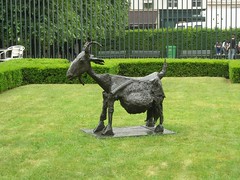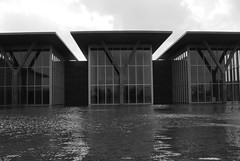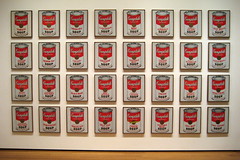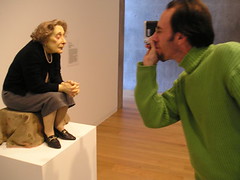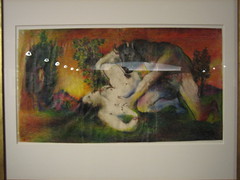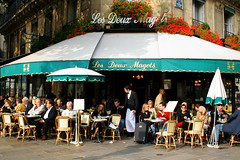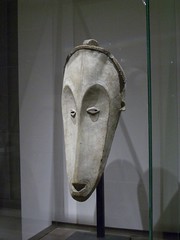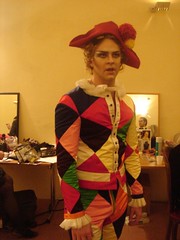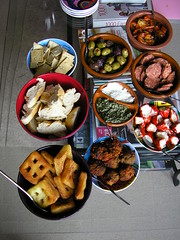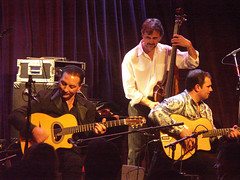Warhol worked across a wide range of media, says Wikipedia – painting, photography, drawing, and sculpture.
In addition, he was a highly prolific filmmaker. Between 1963 and 1968, he made more than 60 films[45], plus some 500 short black and white "screen test" portraits of Factory visitors.[46]
One of his most famous films, Sleep, monitors poet John Giorno sleeping for six hours. The 35-minute film Blow Job, is one continuous shot of the face of DeVeren Bookwalter supposedly receiving oral sex from filmmaker Willard Maas, although the camera never tilts down to see this.
Another, 1964's Empire, consists of eight hours of footage of the Empire State Building in New York City at dusk. The film Eat consists of a man eating a mushroom for 45 minutes.
Warhol attended the 1962 premiere of the static composition by LaMonte Young called Trio for Strings and subsequently created his famous series of static films including Kiss, Eat, and Sleep (for which Young initially was commissioned to provide music). Uwe Husslein cites filmmaker Jonas Mekas, who accompanied Warhol to the Trio premiere, and who claims Warhol's static films were directly inspired by the performance.[47]
His most popular and critically successful film was 1966's Chelsea Girls. The film was highly innovative in that it consisted of two 16 mm films being projected simultaneously, with two different stories being shown in tandem. From the projection booth, the sound would be raised for one film to elucidate that "story" while it was lowered for the other. The multiplication of images evoked Warhol's seminal silk-screen works of the early 1960s.
Other important films include Bike Boy, My Hustler, and Lonesome Cowboys, a raunchy pseudo-western.
These and other titles document gay underground and camp culture, and continue to feature prominently in scholarship about sexuality and art.[48][49]
Blue Movie, a film in which Warhol superstar Viva makes love and fools around in bed with a man for 33 minutes of the film's playing-time, was Warhol's last film as director. The film was at the time scandalous for its frank approach to a sexual encounter.
After his June 3, 1968 shooting, a reclusive Warhol relinquished his personal involvement in filmmaking.
His acolyte and assistant director, Paul Morrissey, took over the film-making chores for the Factory collective, steering Warhol-branded cinema towards more mainstream, narrative-based, B-movie exploitation fare with Flesh, Trash, and Heat.
All of these films, including the later Andy Warhol's Dracula and Andy Warhol's Frankenstein, were far more mainstream than anything Warhol as a director had attempted. These latter "Warhol" films starred Joe Dallesandro, who was more of a Morrissey star than a true Warhol superstar.
Thursday, October 29, 2009
Wednesday, October 28, 2009
Essay on Picasso: use specific examples such as the famous She-Goat sculpture
- 15 pt essay of about 1 page, Google Doc, under the general heading of What made Picasso so Successful?
- Reference and describe at least 2 of his pieces.
- Refer to at least 2 other artists.
- Refer to the geography.
- Due Mon.
Pablo Ruiz Picasso threw a slab of clay onto a board. He grabbed wood lathing and fashioned an animal-like armature. He began to smack lumps of clay onto the frame. A goat began to take shape.
Today, that animal has been cast in bronze and resides in the Metropolitan Museum of Art, NYC.
PIcasso saw himself as a minotaur, a bull-headed creature, not a goat. But because he lived so long - to age 93 - he had to confront the fact that he was, in some ways, a horny and simple goat.
This multi-faceted artist was enormously successful - the most powerful name in 20th century painting and sculpture, says Wikipedia.com. What was the ingredient that catapulted him past Matisse and Man Ray and Dali? It was his sense of the magical in life.
On the one hand, Picasso was a serious student of what worked in art. He was a steady consumer of the best European art as seen in the great museums of Paris, Madrid and Barcelona. He knew what worked for his predescessors: among them Velazquez, El Greco and Michelangelo.
But it was his ability to release the playful inner child in his sketches that proved to be the spine of his upright gorilla.
- Reference and describe at least 2 of his pieces.
- Refer to at least 2 other artists.
- Refer to the geography.
- Due Mon.
Pablo Ruiz Picasso threw a slab of clay onto a board. He grabbed wood lathing and fashioned an animal-like armature. He began to smack lumps of clay onto the frame. A goat began to take shape.
Today, that animal has been cast in bronze and resides in the Metropolitan Museum of Art, NYC.
PIcasso saw himself as a minotaur, a bull-headed creature, not a goat. But because he lived so long - to age 93 - he had to confront the fact that he was, in some ways, a horny and simple goat.
This multi-faceted artist was enormously successful - the most powerful name in 20th century painting and sculpture, says Wikipedia.com. What was the ingredient that catapulted him past Matisse and Man Ray and Dali? It was his sense of the magical in life.
On the one hand, Picasso was a serious student of what worked in art. He was a steady consumer of the best European art as seen in the great museums of Paris, Madrid and Barcelona. He knew what worked for his predescessors: among them Velazquez, El Greco and Michelangelo.
But it was his ability to release the playful inner child in his sketches that proved to be the spine of his upright gorilla.
Picasso in the Dallas Museum of Art
The recent scouting trip by your teacher and family encompassed extensive visits to the DMA, the Nasher Sculpture Center, Crow Museum of Asian Art and the Meadows @ SMU.
See slide show here.
See slide show here.
Tuesday, October 27, 2009
Fernande, Eva, Gaby, Olga: Picasso's numerous consorts
Picasso had two wives (Olga and Jacqueline) and four children by three women.
At the site http://www.sapergalleries.com/PicassoWomen.html you will find a summary that will provide a better understanding of eight of Picasso's major relationships.
Tuesday, October 20, 2009
Exquisite Corpse piece 003
Exquisite corpse (also known as "exquisite cadaver" or "rotating corpse") is a method by which a collection of words or images is collectively assembled, says Wikipedia, the result being known as the exquisite corpse or cadavre exquis in French.
Each collaborator adds to a composition in sequence, either by following a rule (e.g. "The adjective noun adverb verb the adjective noun") or by being allowed to see the end of what the previous person contributed.
The technique was invented by Surrealists and is similar to an old parlour game called Consequences in which players write in turn on a sheet of paper, fold it to conceal part of the writing, and then pass it to the next player for a further contribution.
Surrealism principal founder André Breton reported that it started in fun, but became playful and eventually enriching.
Each collaborator adds to a composition in sequence, either by following a rule (e.g. "The adjective noun adverb verb the adjective noun") or by being allowed to see the end of what the previous person contributed.
The technique was invented by Surrealists and is similar to an old parlour game called Consequences in which players write in turn on a sheet of paper, fold it to conceal part of the writing, and then pass it to the next player for a further contribution.
Surrealism principal founder André Breton reported that it started in fun, but became playful and eventually enriching.
Wed, Nov 18, 7:30 am: Magnet tour to museums in Ft. Worth
Trip to see the Ft Worth museums as planned by Mrs Wendy Reed:
a) Red River Coach 56-seat tour bus
b) $34
c) depart Magnet at 7:30 am
d) 3 great museums: the Kimbell, Amon Carter & FW Modern
e) self-packed lunch / picnic at the downtown Ft Worth Water Gardens
f) fast food stop on return
g) no museum fees
h) money for trip due Nov 9
i) return about 8 pm
I highly, highly recommend this trip. You may say to yourself, "oh, I've got to work," or "I'm short of money right now," but in the long run it is a serious investment in your education. Therefore, trade out at work. Ask family members to help you with the expense money.
This more than good fun. It's a door that opens, deliciously, on your lovely future.
a) Red River Coach 56-seat tour bus
b) $34
c) depart Magnet at 7:30 am
d) 3 great museums: the Kimbell, Amon Carter & FW Modern
e) self-packed lunch / picnic at the downtown Ft Worth Water Gardens
f) fast food stop on return
g) no museum fees
h) money for trip due Nov 9
i) return about 8 pm
I highly, highly recommend this trip. You may say to yourself, "oh, I've got to work," or "I'm short of money right now," but in the long run it is a serious investment in your education. Therefore, trade out at work. Ask family members to help you with the expense money.
This more than good fun. It's a door that opens, deliciously, on your lovely future.
Sunday, October 18, 2009
Andy Warhol, consumerism and irony
It was during the 1960s that Warhol began to make paintings of iconic American products such as Campbell's Soup Cans and Coca-Cola bottles, says Wikipedia, as well as paintings of celebrities such as Marilyn Monroe, Elvis Presley, Troy Donahue, Muhammad Ali and Elizabeth Taylor.
He founded "The Factory", his studio during these years, and gathered around himself a wide range of artists, writers, musicians, and underground celebrities. He began producing prints using the silkscreen method. His work became popular and controversial.
Among the imagery tackled by Warhol were dollar bills, celebrities and brand name products. He also used as imagery for his paintings newspaper headlines or photographs of mushroom clouds, electric chairs, and police dogs attacking civil rights protesters. Warhol also used Coca Cola bottles as subject matter for paintings. He had this to say about Coca Cola:
What's great about this country is that America started the tradition where the richest consumers buy essentially the same things as the poorest. You can be watching TV and see Coca Cola, and you know that the President drinks Coca Cola, Liz Taylor drinks Coca Cola, and just think, you can drink Coca Cola, too. A coke is a coke and no amount of money can get you a better coke than the one the bum on the corner is drinking. All the cokes are the same and all the cokes are good. Liz Taylor knows it, the President knows it, the bum knows it, and you know it.[10]
New York's Museum of Modern Art hosted a Symposium on pop art in December 1962 during which artists like Warhol were attacked for "capitulating" to consumerism. Critics were scandalized by Warhol's open embrace of market culture. This symposium set the tone for Warhol's reception. Throughout the decade it became more and more clear that there had been a profound change in the culture of the art world, and that Warhol was at the center of that shift.
He founded "The Factory", his studio during these years, and gathered around himself a wide range of artists, writers, musicians, and underground celebrities. He began producing prints using the silkscreen method. His work became popular and controversial.
Among the imagery tackled by Warhol were dollar bills, celebrities and brand name products. He also used as imagery for his paintings newspaper headlines or photographs of mushroom clouds, electric chairs, and police dogs attacking civil rights protesters. Warhol also used Coca Cola bottles as subject matter for paintings. He had this to say about Coca Cola:
What's great about this country is that America started the tradition where the richest consumers buy essentially the same things as the poorest. You can be watching TV and see Coca Cola, and you know that the President drinks Coca Cola, Liz Taylor drinks Coca Cola, and just think, you can drink Coca Cola, too. A coke is a coke and no amount of money can get you a better coke than the one the bum on the corner is drinking. All the cokes are the same and all the cokes are good. Liz Taylor knows it, the President knows it, the bum knows it, and you know it.[10]
New York's Museum of Modern Art hosted a Symposium on pop art in December 1962 during which artists like Warhol were attacked for "capitulating" to consumerism. Critics were scandalized by Warhol's open embrace of market culture. This symposium set the tone for Warhol's reception. Throughout the decade it became more and more clear that there had been a profound change in the culture of the art world, and that Warhol was at the center of that shift.
NYC - MoMA: Andy Warhol's Campbell's Soup Cans, 1962
Andrew Warhola (August 6, 1928 – February 22, 1987), more commonly known as Andy Warhol, was an American painter, printmaker, and filmmaker who was a leading figure in the visual art movement known as pop art, says Wikipedia.
After a successful career as a commercial illustrator, Warhol became famous worldwide for his work as a painter, avant-garde filmmaker, record producer, author, and public figure known for his membership in wildly diverse social circles that included bohemian street people, distinguished intellectuals, Hollywood celebrities and wealthy aristocrats.
He coined the expression "15 minutes of fame".
In his hometown of Pittsburgh, Pennsylvania, the Andy Warhol Museum exists in memory of his life and artwork.
After a successful career as a commercial illustrator, Warhol became famous worldwide for his work as a painter, avant-garde filmmaker, record producer, author, and public figure known for his membership in wildly diverse social circles that included bohemian street people, distinguished intellectuals, Hollywood celebrities and wealthy aristocrats.
He coined the expression "15 minutes of fame".
In his hometown of Pittsburgh, Pennsylvania, the Andy Warhol Museum exists in memory of his life and artwork.
Friday, October 16, 2009
The major source for images by Keith Haring: Haring.com
Keith Haring, 1958 - 1990
The Keith Haring Foundation was established in 1989 to assist AIDS-related and children's charities, and maintains the largest resource of archives on the late artist, Keith Haring.
Haring's bold lines and active figures carry poignant messages of vitality and unity. His legacy made an impact on late 20th century art and grants us all a vision for the future.
The Keith Haring Foundation was established in 1989 to assist AIDS-related and children's charities, and maintains the largest resource of archives on the late artist, Keith Haring.
Haring's bold lines and active figures carry poignant messages of vitality and unity. His legacy made an impact on late 20th century art and grants us all a vision for the future.
Wednesday, October 14, 2009
Dying Bull - Pablo Picasso vocab

Dying Bull - Pablo Picasso - Série de Nova Iorque: o Museu de Arte Metropolitan - New York's series: The Metropolitan Museum of Art - IMG_20080727_8856
Originally uploaded by Flávio Cruvinel Brandão
Francois Gilot
Antibes
plywood
Cannes
Valauris
"to tickle the mind"
ceramics
Villa Californie
Notre Dame de Vie
Château de Vauvenargues: near the Provençal town of Aix-en-Provence there is a simple mound of earth, covered in grass and ringed by ivy. Perched on top is a curvaceous bronze nude, made by Pablo Picasso in 1933, and exhibited alongside Guernica in the Paris international exhibition of 1937. But, in terms of significance, it doesn’t come close to what lies beneath: the body of the artist himself.
This summer, 36 years after Picasso’s death, the château in the south of France opens its gates to the public for the first time. The Spanish artist bought Château de Vauvenargues in 1958 after he discovered it in the foothills of Mont Sainte-Victoire, the mountain immortalised in countless paintings by Paul Cézanne, the man Picasso regarded as his artistic father.
age 91, 1973
Magnet arts trip to Ft Worth Modern, Kimbell, etc, on Tues, Nov 3
A 56-person bus is being lined up by art history teacher Mrs. Wendy Reed for a tour of Ft Worth museums on Tues, Nov 3.
Stand by for the cost.
Ft Worth Modern
Kimbell Art Museum
Amon Carter Museum / American Art.
Stand by for the cost.
Ft Worth Modern
Kimbell Art Museum
Amon Carter Museum / American Art.
Tuesday, October 13, 2009
The Picasso project
There are 2 parts to the Picasso project -
Visualising Picasso
- 10 images of his work (at least one sculpture and one ceramic work) that are spaced across his long career with brief notation of title, year, museum where the work is found or location of Picasso when he completed the piece. .
Knowing Picasso
- Write 10 multiple-choice questions that span his life and emphasize the primary points of his biography.
Google Docs.
15 pts each.
Picasso Presentation to be shown to the class beginning Tues, Oct 20. Picasso Bio Quiz due in GogleDoc Tues, Oct 20. My plan is to synthesize your questions into an end-of-unit test to be taken Thurs, Oct 22.
Visualising Picasso
- 10 images of his work (at least one sculpture and one ceramic work) that are spaced across his long career with brief notation of title, year, museum where the work is found or location of Picasso when he completed the piece. .
Knowing Picasso
- Write 10 multiple-choice questions that span his life and emphasize the primary points of his biography.
Google Docs.
15 pts each.
Picasso Presentation to be shown to the class beginning Tues, Oct 20. Picasso Bio Quiz due in GogleDoc Tues, Oct 20. My plan is to synthesize your questions into an end-of-unit test to be taken Thurs, Oct 22.
Friday, October 9, 2009
Fine Arts class total assignments at end of 9 weeks

Boston Marriage: Kari Kennon, Kelly Mills, LSUS Black Box Theater, Th, Oct 8; LSUS photo
Originally uploaded by trudeau
1. Comparsion essay / profile of 2 classmates.
2. Graffiti @ Artspace
3. RW Norton Art Foundation
4. Photo essay / RW Norton grounds
5. Art of Africa project
6. Arts Experience for Sept. (restaurant, movie, drama, etc)
7. Southern University Museum of Art Shreveport
These works will each be scored at 15 points.
Additional projects for which you have points -
- Notes on graffiti artists - 11 pts.
- Sculpture / soap relief carving - 5 pts.
Thursday, October 8, 2009
Fine Arts vocab: misogynist, machismo, pacifism
Fine arts vocab:
* misogynist - Misogyny (pronounced /mɪˈsɒdʒɪni/) is hatred (or contempt) of women or girls. Misogyny comes from Greek misogunia (μισογυνία) from misos (μῖσος, "hatred") and gynē (γυνή, "woman"). It is parallel to misandry—the hatred of men or boys. Misogyny is also comparable with (but not the same as) misanthropy which is the hatred of humanity in general. The prefix miso-, meaning 'Hatred' or 'To hate' applies in many other words, such as misandry, misocapny, misogomy, misarchy and misoxeny.
Greek philosophers considered misogyny to be caused by gynophobia, a fear of women.[1] In the late 20th century, feminist theorists proposed misogyny as both a cause and result of patriarchal social structures.[2]
* machismo - Machismo is prominently exhibited or excessive masculinity.[1] As an attitude, machismo ranges from a personal sense of virility to a more extreme male chauvinism. In many cultures, machismo is acceptable and even expected.
* pax - pacifist - Pacifism is the opposition to war or violence as a means of settling disputes or gaining advantage. Pacifism covers a spectrum of views ranging from the belief that international disputes can and should be peacefully resolved; to calls for the abolition of the institutions of the military and war; to opposition to any organization of society through governmental force (anarchist or libertarian pacifism); to rejection of the use of physical violence to obtain political, economic or social goals; to the obliteration of force except in cases where it is absolutely necessary to advance the cause of peace; to opposition to violence under any circumstance, including defense of self and others.
Beginning in the 16th century, the Protestant Reformation gave rise to a variety of new Christian sects, including the historic peace churches. Foremost among them were the Religious Society of Friends (Quakers), Amish, Mennonites and Church of the Brethren. After its founding by Quaker pacifist William Penn, Quaker-controlled colonial Pennsylvania employed an anti-militarist public policy. Unlike residents of many of the colonies, Quakers chose to trade peacefully with the Indians, including for land. The colonial province was, for the 75 years from 1681 to 1756, essentially unarmed and experienced little or no warfare in that period.
* misogynist - Misogyny (pronounced /mɪˈsɒdʒɪni/) is hatred (or contempt) of women or girls. Misogyny comes from Greek misogunia (μισογυνία) from misos (μῖσος, "hatred") and gynē (γυνή, "woman"). It is parallel to misandry—the hatred of men or boys. Misogyny is also comparable with (but not the same as) misanthropy which is the hatred of humanity in general. The prefix miso-, meaning 'Hatred' or 'To hate' applies in many other words, such as misandry, misocapny, misogomy, misarchy and misoxeny.
Greek philosophers considered misogyny to be caused by gynophobia, a fear of women.[1] In the late 20th century, feminist theorists proposed misogyny as both a cause and result of patriarchal social structures.[2]
* machismo - Machismo is prominently exhibited or excessive masculinity.[1] As an attitude, machismo ranges from a personal sense of virility to a more extreme male chauvinism. In many cultures, machismo is acceptable and even expected.
* pax - pacifist - Pacifism is the opposition to war or violence as a means of settling disputes or gaining advantage. Pacifism covers a spectrum of views ranging from the belief that international disputes can and should be peacefully resolved; to calls for the abolition of the institutions of the military and war; to opposition to any organization of society through governmental force (anarchist or libertarian pacifism); to rejection of the use of physical violence to obtain political, economic or social goals; to the obliteration of force except in cases where it is absolutely necessary to advance the cause of peace; to opposition to violence under any circumstance, including defense of self and others.
Beginning in the 16th century, the Protestant Reformation gave rise to a variety of new Christian sects, including the historic peace churches. Foremost among them were the Religious Society of Friends (Quakers), Amish, Mennonites and Church of the Brethren. After its founding by Quaker pacifist William Penn, Quaker-controlled colonial Pennsylvania employed an anti-militarist public policy. Unlike residents of many of the colonies, Quakers chose to trade peacefully with the Indians, including for land. The colonial province was, for the 75 years from 1681 to 1756, essentially unarmed and experienced little or no warfare in that period.
The tragedy of war painting called Guernica: 11' X 26' oil on canvas
Guernica is a painting by Pablo Picasso, depicting the bombing of Guernica, Spain, by German and Italian warplanes at the behest of the Spanish Nationalist forces, on April 26, 1937, during the Spanish Civil War. The Spanish Republican government commissioned Pablo Picasso, says Wikipedia, to create a large mural for the Spanish display at the Exposition Internationale des Arts et Techniques dans la Vie Moderne (1937) Paris International Exposition in the 1937 World's Fair in Paris.
Guernica shows the tragedies of war and the suffering it inflicts upon individuals, particularly innocent civilians. This work has gained a monumental status, becoming a perpetual reminder of the tragedies of war, an anti-war symbol, and an embodiment of peace. On completion Guernica was displayed around the world in a brief tour, becoming famous and widely acclaimed. This tour helped bring the Spanish Civil War to the world's attention.
Guernica shows the tragedies of war and the suffering it inflicts upon individuals, particularly innocent civilians. This work has gained a monumental status, becoming a perpetual reminder of the tragedies of war, an anti-war symbol, and an embodiment of peace. On completion Guernica was displayed around the world in a brief tour, becoming famous and widely acclaimed. This tour helped bring the Spanish Civil War to the world's attention.
Dora and the Minotaur at the Musee Picasso
Picasso portrayed himself as the mischievous Harlequin in early paintings; eventually one of his most commonly-used symbols for himself was the minotaur.
Wikipedia: In Greek mythology, the Minotaur (Greek: Μῑνώταυρος, Mīnṓtauros), as the Greeks imagined him, was a creature with the head of a bull on the body of a man[1] or, as described by Ovid, "part man and part bull."[2] He dwelt at the center of the Cretan Labyrinth, which was an elaborate maze-like construction[3] built for King Minos of Crete and designed by the architect Daedalus and his son Icarus who were ordered to build it to hold the Minotaur. The Minotaur was eventually killed by Theseus, the son of Aegeas.
Wikipedia: In Greek mythology, the Minotaur (Greek: Μῑνώταυρος, Mīnṓtauros), as the Greeks imagined him, was a creature with the head of a bull on the body of a man[1] or, as described by Ovid, "part man and part bull."[2] He dwelt at the center of the Cretan Labyrinth, which was an elaborate maze-like construction[3] built for King Minos of Crete and designed by the architect Daedalus and his son Icarus who were ordered to build it to hold the Minotaur. The Minotaur was eventually killed by Theseus, the son of Aegeas.
Famous bars of the world: Les Deux Magots in Paris, St Germain des Pres neighborhood
Les Deux Magots is a famous[1] café in the Saint-Germain-des-Prés area of Paris, France. It once had a reputation as the rendezvous of the literary and intellectual élite of the city, says Wikipedia. This derived from the patronage of Surrealist artists, intellectuals such as Simone de Beauvoir and Jean-Paul Sartre, and young writers, such as Ernest Hemingway. Other patrons included Albert Camus and Pablo Picasso.
The Deux Magots literary prize has been awarded to a French novel every year since 1933.
The café's name comes from the two wooden statues of Chinese commercial agents (magots) that adorn one of the pillars.
The Deux Magots literary prize has been awarded to a French novel every year since 1933.
The café's name comes from the two wooden statues of Chinese commercial agents (magots) that adorn one of the pillars.
Wednesday, October 7, 2009
Requiscat in pace, Irving Penn / fashion and Picasso
Irving Penn (June 16, 1917 – October 7, 2009[1]) was an American photographer known for his portraiture and fashion photography, says Wikipedia.
Tuesday, October 6, 2009
Picasso's influences: West African Fang tribe mask in Louvre
During the late 19th and early 20th centuries, says Wikipedia, the European cultural elite were discovering African, Micronesian and Native American art for first time.
Artists such as Paul Gauguin, Henri Matisse and Picasso were intrigued and inspired by the stark power and simplicity of styles of those foreign cultures. Around 1906, Picasso, Matisse, Derain and other artists in Paris had recently acquired an interest in primitivism, Iberian sculpture,[25] African art and tribal masks, in part because of the compelling works of Paul Gauguin that had suddenly achieved center stage in the avant-garde circles of Paris.
Picasso began to see art from the point of view of the tribal world: art was magic. Art could provide an exorcism. Art could be a weapon. Picasso saw himself as a shaman.
The omnivorous Picasso devoured another style and concept.
Artists such as Paul Gauguin, Henri Matisse and Picasso were intrigued and inspired by the stark power and simplicity of styles of those foreign cultures. Around 1906, Picasso, Matisse, Derain and other artists in Paris had recently acquired an interest in primitivism, Iberian sculpture,[25] African art and tribal masks, in part because of the compelling works of Paul Gauguin that had suddenly achieved center stage in the avant-garde circles of Paris.
Picasso began to see art from the point of view of the tribal world: art was magic. Art could provide an exorcism. Art could be a weapon. Picasso saw himself as a shaman.
The omnivorous Picasso devoured another style and concept.
Pablo Picasso - Les Demoiselles D'Avignon
Les Demoiselles d'Avignon (The Young Ladies of Avignon) is a large oil painting of 1907 by Pablo Picasso (1881–1973) which portrays five nude female prostitutes in a brothel on Avinyó Street in Barcelona, says Wikipedia.
All of the figures depicted are physically jarring, none conventionally feminine, all slightly menacing, and each is rendered with angular and disjointed body shapes. Two of the women are rendered with African mask-like faces, giving them a savage and mysterious aura.
In his adaption of Primitivism and abandonment of perspective in favor of a flat, two-dimensional picture plane, Picasso makes a radical departure from traditional European painting. The work is one of Picasso's most famous, and is widely considered to be a seminal work in the early development of both Cubism and modern art. It is in the collection of the Museum of Modern Art in New York City, having been acquired by the museum in 1939.[1]
While he already had a considerable following by the middle of 1906, Picasso enjoyed further success with his paintings of massive over-sized nude women, monumental sculptural figures that recalled the work of Paul Gauguin and showed his interest in primitive (African, Micronesian, Native American) art.
All of the figures depicted are physically jarring, none conventionally feminine, all slightly menacing, and each is rendered with angular and disjointed body shapes. Two of the women are rendered with African mask-like faces, giving them a savage and mysterious aura.
In his adaption of Primitivism and abandonment of perspective in favor of a flat, two-dimensional picture plane, Picasso makes a radical departure from traditional European painting. The work is one of Picasso's most famous, and is widely considered to be a seminal work in the early development of both Cubism and modern art. It is in the collection of the Museum of Modern Art in New York City, having been acquired by the museum in 1939.[1]
While he already had a considerable following by the middle of 1906, Picasso enjoyed further success with his paintings of massive over-sized nude women, monumental sculptural figures that recalled the work of Paul Gauguin and showed his interest in primitive (African, Micronesian, Native American) art.
Picasso, his friends and the narcotic called opium at the turn of the century
Opium is a narcotic formed from the latex released by lacerating (or "scoring") the immature seed pods of opium poppies (Papaver somniferum). It contains up to 12% morphine, an opiate alkaloid, which is most frequently processed chemically to produce heroin for the illegal drug trade.
Cultivation of opium poppies for food, anesthesia, and ritual purposes dates back to at least the Neolithic Age. The Sumerian, Assyrian, Egyptian, Minoan, Greek, Roman, Persian and Arab Empires each made widespread use of opium, which was the most potent form of pain relief then available, allowing ancient surgeons to perform prolonged surgical procedures.
Opium is mentioned in the most important medical texts of the ancient world, including the Ebers Papyrus and the writings of Dioscorides, Galen, and Avicenna.
Widespread medical use of unprocessed opium continued through the American Civil War before giving way to morphine and its successors, which could be injected at a precisely controlled dosage. American morphine is still produced primarily from poppies grown and processed in India in the traditional manner and remains the standard of pain relief for casualties of war.
Cultivation of opium poppies for food, anesthesia, and ritual purposes dates back to at least the Neolithic Age. The Sumerian, Assyrian, Egyptian, Minoan, Greek, Roman, Persian and Arab Empires each made widespread use of opium, which was the most potent form of pain relief then available, allowing ancient surgeons to perform prolonged surgical procedures.
Opium is mentioned in the most important medical texts of the ancient world, including the Ebers Papyrus and the writings of Dioscorides, Galen, and Avicenna.
Widespread medical use of unprocessed opium continued through the American Civil War before giving way to morphine and its successors, which could be injected at a precisely controlled dosage. American morphine is still produced primarily from poppies grown and processed in India in the traditional manner and remains the standard of pain relief for casualties of war.
Harlequin: hellequin, a black-faced emissary of the devil
The name of Harlequin derives from Old French Hellequin, thought to be related to the Old English Herla, a character often identified with Woden.[1][2]
Italian Arlecchino by folk etymology was associated with Latin Herculinus, "little Hercules".[citation needed]
Although illustrations of Arlecchino have only been dated as far back as 1572, the character had existed before this date. The origins of the name are uncertain: some say it comes from Dante's Inferno, XXI, XXII and XXIII; one of the devils in Hell having the name Alichino.
Popular theories suggest that he may have come from France, Africa, or Italy.
The notion that the Harlequin motif grew out of France is evidenced by Hellequin, a stock character in French passion plays. Hellequin, a black-faced emissary of the devil, is said to have roamed the countryside with a group of demons chasing the damned souls of evil people to Hell. The physical appearance of Hellequin offers an explanation for the traditional colours of Harlequin's mask (red and black).[3]
The Harlequin character may have been based on or influenced by the Zanni archetype who, although a slow thinker, was acrobatic and nimble.[4] Interpreted thus, Harlequin's distinctive motley costume may be a stylized variant of Zanni's plain white garb, designed to reflect the ad-hoc patching necessary to prevent the garment's degradation.
Italian Arlecchino by folk etymology was associated with Latin Herculinus, "little Hercules".[citation needed]
Although illustrations of Arlecchino have only been dated as far back as 1572, the character had existed before this date. The origins of the name are uncertain: some say it comes from Dante's Inferno, XXI, XXII and XXIII; one of the devils in Hell having the name Alichino.
Popular theories suggest that he may have come from France, Africa, or Italy.
The notion that the Harlequin motif grew out of France is evidenced by Hellequin, a stock character in French passion plays. Hellequin, a black-faced emissary of the devil, is said to have roamed the countryside with a group of demons chasing the damned souls of evil people to Hell. The physical appearance of Hellequin offers an explanation for the traditional colours of Harlequin's mask (red and black).[3]
The Harlequin character may have been based on or influenced by the Zanni archetype who, although a slow thinker, was acrobatic and nimble.[4] Interpreted thus, Harlequin's distinctive motley costume may be a stylized variant of Zanni's plain white garb, designed to reflect the ad-hoc patching necessary to prevent the garment's degradation.
At the Lapin Agile, 1905, Pablo Picasso in Montmartre, Paris
Lapin Agile is a famous Montmartre cabaret, at 22 Rue des Saules, Paris, France, says Wikipedia.
In 1875 the artist Andre Gill painted the sign that was to suggest its permanent name. It was a picture of a rabbit jumping out of a saucepan, and residents began calling their neighborhood night-club "Le Lapin à Gill", meaning "Gill's rabbit".
Over time the name evolved into "Cabaret Au Lapin Agile", or, the Nimble Rabbit Cabaret. At the turn of the twentieth century, the Lapin Agile was a favorite spot for struggling artists and writers, including Picasso, Modigliani, Apollinaire, and Utrillo.
The Lapin Agile is located in the center of the Montmartre district of Paris, behind Sacre Coeur Basilica. Since this was the heart of artistic Paris at the turn of the twentieth century, there was much discussion at the cabaret about "the meaning of art".
Au Lapin Agile also was popular with questionable Montmartre characters including pimps, eccentrics, simple down-and-outers, a contingent of local anarchists, as well as with students from the Latin Quarter, all mixed with a sprinkling of well-heeled bourgeois out on a lark.
Pablo Picasso's 1905 oil painting "At the Lapin Agile" helped to make this cabaret world famous. The cabaret was often captured on canvas by another Montmartre artist, Maurice Utrillo.
In 1993 American comedian and entertainer, Steve Martin, wrote a play, Picasso at the Lapin Agile, which depicted an imagined meeting between Pablo Picasso and Albert Einstein at the bar.
In 1875 the artist Andre Gill painted the sign that was to suggest its permanent name. It was a picture of a rabbit jumping out of a saucepan, and residents began calling their neighborhood night-club "Le Lapin à Gill", meaning "Gill's rabbit".
Over time the name evolved into "Cabaret Au Lapin Agile", or, the Nimble Rabbit Cabaret. At the turn of the twentieth century, the Lapin Agile was a favorite spot for struggling artists and writers, including Picasso, Modigliani, Apollinaire, and Utrillo.
The Lapin Agile is located in the center of the Montmartre district of Paris, behind Sacre Coeur Basilica. Since this was the heart of artistic Paris at the turn of the twentieth century, there was much discussion at the cabaret about "the meaning of art".
Au Lapin Agile also was popular with questionable Montmartre characters including pimps, eccentrics, simple down-and-outers, a contingent of local anarchists, as well as with students from the Latin Quarter, all mixed with a sprinkling of well-heeled bourgeois out on a lark.
Pablo Picasso's 1905 oil painting "At the Lapin Agile" helped to make this cabaret world famous. The cabaret was often captured on canvas by another Montmartre artist, Maurice Utrillo.
In 1993 American comedian and entertainer, Steve Martin, wrote a play, Picasso at the Lapin Agile, which depicted an imagined meeting between Pablo Picasso and Albert Einstein at the bar.
Monday, October 5, 2009
Symbol of Spain, of Andalusia: the Arabic-European fortress-palace called the Alhambra
The Alhambra (Arabic: الْحَمْرَاء, Al-Ħamrā, literally "the red one"), is a palace and fortress complex of the Moorish rulers of Granada in southern Spain (known as Al-Andalus when the fortress was constructed during the mid 14th century), occupying a hilly terrace on the southeastern border of the city of Granada, says Wikipedia.
Once the residence of the Muslim rulers of Granada and their court, the Alhambra is now one of Spain's major tourist attractions exhibiting the country's most famous Islamic architecture, together with Christian 16th century and later interventions in buildings and gardens that marked its image as it can be seen today.
Once the residence of the Muslim rulers of Granada and their court, the Alhambra is now one of Spain's major tourist attractions exhibiting the country's most famous Islamic architecture, together with Christian 16th century and later interventions in buildings and gardens that marked its image as it can be seen today.
Tapas: fine arts food of Espana
Tapas (tah pas) is the name of a wide variety of appetizers, or snacks, in Spanish cuisine. They may be cold (such as mixed olives and cheese) or warm (such as puntillitas, which are battered, fried baby squid).
The serving of tapas - with wine - is designed to encourage conversation because people are not so focused upon eating an entire meal that is set before them.[citation needed] Also, in some countries it is customary for diners to stand and move about while eating tapas.
Tapas evolved over Spain's history through the incorporation of ingredients and influences from many different cultures and countries. Most of the Iberian Peninsula was invaded by the Romans, who introduced the olive and irrigation methods. The invasion of the North African Moors in the 8th century brought almonds, citrus fruits and fragrant spices. The influence of their 700-year presence remains today, especially in Andalusia. The discovery of the New World brought the introduction of tomatoes, sweet and chili peppers, maize (corn), beans and potatoes. These were readily accepted and easily grown in Spain's microclimates.
The serving of tapas - with wine - is designed to encourage conversation because people are not so focused upon eating an entire meal that is set before them.[citation needed] Also, in some countries it is customary for diners to stand and move about while eating tapas.
Tapas evolved over Spain's history through the incorporation of ingredients and influences from many different cultures and countries. Most of the Iberian Peninsula was invaded by the Romans, who introduced the olive and irrigation methods. The invasion of the North African Moors in the 8th century brought almonds, citrus fruits and fragrant spices. The influence of their 700-year presence remains today, especially in Andalusia. The discovery of the New World brought the introduction of tomatoes, sweet and chili peppers, maize (corn), beans and potatoes. These were readily accepted and easily grown in Spain's microclimates.
Quirky but evocative: the animated view of life in paris called The Triplets of Belleville
The Triplets of Belleville is a Belgium-Quebec-France coproduced 2003 animated feature film written and directed by Sylvain Chomet. It was an international co-production between companies in France, United Kingdom, Belgium and Canada.
There is little dialogue, the majority of the film story being told through song and pantomime. It tells the story of Madame Souza, an elderly woman who goes on a quest to rescue her grandson Champion, who has been kidnapped by the French mafia and taken to the city of Belleville. She is joined by the triplets of Belleville, music hall singers from the 1930s, who she meets in the city, and her dog Bruno.
The film was highly praised by audiences and critics for its unique (and somewhat retro) style of animation. The film was nominated for two Academy Awards — Best Animated Feature and Best Original Song for "Belleville Rendez-vous".
There is little dialogue, the majority of the film story being told through song and pantomime. It tells the story of Madame Souza, an elderly woman who goes on a quest to rescue her grandson Champion, who has been kidnapped by the French mafia and taken to the city of Belleville. She is joined by the triplets of Belleville, music hall singers from the 1930s, who she meets in the city, and her dog Bruno.
The film was highly praised by audiences and critics for its unique (and somewhat retro) style of animation. The film was nominated for two Academy Awards — Best Animated Feature and Best Original Song for "Belleville Rendez-vous".
Gypsy hero: Belgian jazz guitarist Django Reinhardt
Jean "Django" Reinhardt (1910 – 1953) was a Belgian Gypsy jazz guitarist, says Wikipedia.
One of the first prominent European jazz musicians, Reinhardt remains one of the most renowned jazz guitarists due to his innovative and distinctive playing. With violinist Stéphane Grappelli he cofounded the Quintette du Hot Club de France, described by critic Thom Jurek[2] as "one of the most original bands in the history of recorded jazz." Reinhardt's most popular compositions have become jazz standards.
One of the first prominent European jazz musicians, Reinhardt remains one of the most renowned jazz guitarists due to his innovative and distinctive playing. With violinist Stéphane Grappelli he cofounded the Quintette du Hot Club de France, described by critic Thom Jurek[2] as "one of the most original bands in the history of recorded jazz." Reinhardt's most popular compositions have become jazz standards.
One of the national dishes of Spain: Paella (pie-A-ya)
Paella (Spanish pronunciation: [paˈeʎa]) is a rice dish that originated in its modern form in the mid-19th century near the eastern coast of Spain's Valencian region.[1]
Many non-Spaniards view paella as Spain's national dish.
There are three widely known types of paella: Valencian paella (Spanish: paella valenciana), seafood paella (Spanish: paella de marisco) and mixed paella (Spanish: paella mixta); but there are many others as well.
Valencian paella consists of white rice, green vegetables, meat, snails, beans and seasoning. Seafood paella replaces meat and snails with seafood and omits beans and green vegetables. Mixed paella is a free-style combination of meat, seafood, vegetables and sometimes beans.
Most paella chefs use calasparra[2][3]or bomba[3]rices for this dish. Other key ingredients include saffron and olive oil.
Many non-Spaniards view paella as Spain's national dish.
There are three widely known types of paella: Valencian paella (Spanish: paella valenciana), seafood paella (Spanish: paella de marisco) and mixed paella (Spanish: paella mixta); but there are many others as well.
Valencian paella consists of white rice, green vegetables, meat, snails, beans and seasoning. Seafood paella replaces meat and snails with seafood and omits beans and green vegetables. Mixed paella is a free-style combination of meat, seafood, vegetables and sometimes beans.
Most paella chefs use calasparra[2][3]or bomba[3]rices for this dish. Other key ingredients include saffron and olive oil.
NYC - MoMA - Pablo Picasso's Boy Leading a Horse
To read and analyze the story of Pablo Picasso is to have a broad window into the history of the 20th century.
a) He was trained in classic sketching and painting. His early work demonstrated fluency in realistic portrayals of people.
b) In Paris he realized there was more to art than realism.
c) He was challenged to think adventurously by his artistic community in Paris.
d) Ambition and artistic restlessness were among his qualities.
e) Cubism was a radical innovation. It was an edgy adventure and not designed to win friends and commissions. Notice how Cubism remains relevant - see the digital blocks on your malfunctioning video screen - to this day.
f) Like Lennon & McCartney, he was competitive with his peers. He both worked with and in an effort to top fellows like Henri Matisse.
a) He was trained in classic sketching and painting. His early work demonstrated fluency in realistic portrayals of people.
b) In Paris he realized there was more to art than realism.
c) He was challenged to think adventurously by his artistic community in Paris.
d) Ambition and artistic restlessness were among his qualities.
e) Cubism was a radical innovation. It was an edgy adventure and not designed to win friends and commissions. Notice how Cubism remains relevant - see the digital blocks on your malfunctioning video screen - to this day.
f) Like Lennon & McCartney, he was competitive with his peers. He both worked with and in an effort to top fellows like Henri Matisse.
Friday, October 2, 2009
Guidelines for arts reviews, whether indie movie, play, art exhibit, concert, etc.
1. Vivid opening. Describe an image you thought was one of the best elements of the show. Write with color and vibe.
2. The overall impact or significance of the display or performance. Ex: The Graffiti show at Artspace attempts to broaden visitors' sense of the definition of fine arts.
3. Principal elements of the event or display. "Sculptures, masks, fabrics, paintings and photos are the principal elements of the museum. One eight foot-tall mahogany sculpture of a warrior was entitled 'The Hunter.'"
4. Your evaluation: what you think was effective or appealing. Also, what you thought was difficult to understand or to like. Technical successes or problems. Philosophical approval or disagreements.
5. Names of people and / or groups responsible for the production.
6. Location, date(s). Ticket price.
7. Online source for more info.
8. Titling: snappy title, explanatory subtitle.
9. Third person voice at all times.
2. The overall impact or significance of the display or performance. Ex: The Graffiti show at Artspace attempts to broaden visitors' sense of the definition of fine arts.
3. Principal elements of the event or display. "Sculptures, masks, fabrics, paintings and photos are the principal elements of the museum. One eight foot-tall mahogany sculpture of a warrior was entitled 'The Hunter.'"
4. Your evaluation: what you think was effective or appealing. Also, what you thought was difficult to understand or to like. Technical successes or problems. Philosophical approval or disagreements.
5. Names of people and / or groups responsible for the production.
6. Location, date(s). Ticket price.
7. Online source for more info.
8. Titling: snappy title, explanatory subtitle.
9. Third person voice at all times.
'Untitled Self-Portrait' , Talbot Hopkins, 2009, was named best of show in the new exhibit at Artspace
Talbot Hopkins, whose professional work as an artist is in commissioned portraits, was named winner of the $1000 prize for visual art in the new exhibit at Artspace Shreveport.
Her "self-portrait, 2009," reflects her admiration for the portraits of American master Andrew Wyeth.
One of Wyeth's most famous bodies of work is the Helga series. Hopkins has long been entranced by that work.
Her "self-portrait, 2009," reflects her admiration for the portraits of American master Andrew Wyeth.
One of Wyeth's most famous bodies of work is the Helga series. Hopkins has long been entranced by that work.
Thursday, October 1, 2009
Carolyn Coatney at SUMAS: Southern University Museum of Art Shreveport

Carolyn Coatney at SUMAS: Southern University Museum of Art Shreveport
Originally uploaded by trudeau
Students who were not able to go with the group should visit the facility this week. SUMAS is open on Sat, too. Parents are especially encouraged to enjoy this important museum.
# SUMAS is located at 610 Texas Street on the first floor of the SUSLA Metro Center in downtown Shreveport.
# Hours are Tuesday through Friday, 10 a.m until 5 p.m. and Saturday 10 a.m until 4 p.m.
# Admission is free.
318.670.6631

